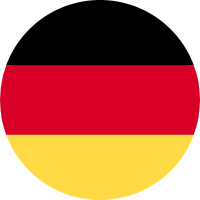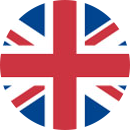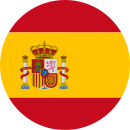Creality is widely acknowledged as a frontrunner in the realm of 3D printing technology. The company is poised to reveal its latest premier product, the K1C 3D Printer, on January 25th. Dubbed the "Champion of Speed and Skills," this new addition to the Creality lineup has been meticulously crafted to cater to the demands of both hobbyists and professional users who prioritize swift printing performance, especially when working with carbon fiber materials. Advancing from the well-received Creality K1, the new Creality K1C model is an enclosed Core XY FDM printer boasting impressive speeds of up to 600 mm/s. Engineered to rival the best in the market, the K1C introduces a pioneering standard featuring an all-metal hotend, a more robust motor system, and a cutting-edge build plate. The K1C distinguishes itself by being fine-tuned for carbon fiber filament usage – the "C" in K1C symbolizing "carbon". Moreover, the K1C's hotend is capable of achieving and sustaining temperatures as high as 300 degrees Celsius. Its direct drive mechanism is specifically designed to handle carbon fiber filament with superior efficiency. Part 1: Creality K1C 3D Printer Technical Advancements Part 2: Creality K1 Series Parameter Comparison Part 3: Creality K1C Printer Applications FAQs about Creality K1C 3D Printer Reliable Extrusion The all-metal extrusion assembly on the K1C ensures reliable printing with a design that firmly grips the filament, resulting in smooth, uninterrupted extrusion for over a thousand hours. Quick-swap Tri-metal Nozzle The K1C sports a "Unicorn" nozzle made from a tri-metal combination, enabling swift nozzle changes with a single hand while resisting heat creep and offering long-lasting performance. 600mm/s Max Printing Speed The CoreXY motion system propels the K1C to an impressive top speed of 600 mm/s, coupled with substantial acceleration capabilities, positioning it as a leader in rapid 3D printing. Supporting Carbon Fiber Filaments Explore creative possibilities with the K1C's ability to handle a range of filaments, including those reinforced with carbon fiber, thanks to its high-temperature nozzle. Intelligent AI Camera An AI Camera enhances the 3D printing process by providing error notifications, live monitoring, and time-lapse recording for a more streamlined experience. Wider Uses: Carbon Fiber Printing Reinvented The K1C expands printing options with its capability to use carbon fiber-infused materials, offering strong and dimensionally stable prints suitable for various applications. Auto Calibration with One Tap The printer's auto-calibration feature ensures easy setup and consistent prints with a single tap. AI Camera Acts as Your Eyes The integrated AI camera serves as your eyes, allowing for error detection and progress tracking remotely via the Creality Print or Creality Cloud app. CoreXY Motion Structure The K1C's CoreXY framework delivers both high printing speeds and exceptional print quality, while a silent mode ensures operation is whisper-quiet. Solid Frame Using Die Cast Parts The robust frame, constructed with large, seamless die-cast components, offers strength and an aesthetically pleasing appearance. See-Through Glass and Lid Transparent glass sides and lid create an attractive thermal enclosure while allowing visibility into the printing process. Active Carbon Filter for Clean Air An active carbon filter promotes a clean printing environment by removing airborne particles and fumes. Details, All for the Best The K1C features additional enhancements such as damping pads, a sturdy damper hinge, safety film, a reinforced cable chain, and a silicone wiper for an optimal printing experience. Make Creality K1C Even More Powerful Expand your K1C's functionality with optional accessories like Creality Hyper Filaments, the Space Pi Filament Dryer, and a textured PEI plate for improved print adhesion. Open-Source Creality Operating System The Klipper-based Creality OS gives users the flexibility to fine-tune their printer or engage with the open-source community for further exploration. Creality Print: A Versatile Slicing Tool With features like intelligent cooling and support structures, Creality Print enhances the slicing process and provides access to a library of 3D models. Creality Cloud: A Vibrant Online Platform Connect with other 3D printing enthusiasts in the Creality Cloud, offering cloud printing, a model library, and community interaction. Comprehensive Support: Continuous Customer Service and Warranty Protection Benefit from Creality's round-the-clock customer service and a 1-year warranty, ensuring complete support for your K1C 3D printer. Coming up, we will present an in-depth analysis of the K1 series specifications to deepen our readers' comprehension of the K1C Printer. ABS/PLA/PETG/PET/TPU/PA/ABS /ASA/PC/PLA-CF/PA-CF/PET-CF 10 Languages: English, Spanish, German, French, Russian, Portuguese, Italian, Turkish, Japanese, Chinese Most common 3D printing material, low cost, easy to print Can be used to print the exterior shell of robots and non-critical structural parts. Used to print robot parts that need to withstand greater forces, such as the robot's main support structure. Suitable for printing robot parts that must withstand high-temperature environments Can be used to print robot tires and other parts that require flexibility Suitable for printing robot parts that must withstand extremely high loads or temperatures. suitable for printing the robot's main support structure and parts that bear high loads. Architectural Model Mainstream 3D printing material, easy print, high precision, multicolor option Can be used to print the main body of architectural models, such as walls and roofs. A mixture of PLA and carbon fibers, higher strength and stiffness Suitable for printing parts that require higher strength, such as support columns of buildings. Suitable for printing parts that need to withstand pressure, such as bridges and support structures. Suitable for printing parts that need to withstand high temperatures,such as chimneys or ovens in models. Suitable for printing parts exposed to prolonged sunlight, like model exteriors, walls, and roofs. Can be used to print flexible parts, such as model doors, window curtains, or small decorative items. High wear resistance & chemical corrosion resistance Suitable for printing parts that require wear resistance, such as floors or steps Can be used to print parts that require a transparent effect, such as windows or glass curtain walls. A mixture of PA and carbon fibers, higher strength and stiffness Ideal for printing bridges or load-bearing walls in buildings. Automotive Design & Manufacturing Can be used to print the car's exterior shell or other parts that do not need to withstand much pressure. Excellent mechanical properties, heat resistance Can be used to print engine parts or transmission systems. Most common use, made from plant starch with biodegradable properties. Can be used to print decorative and non-structural parts, such as lampshades, vases, or small decorative objects. Modified form of PLA, with added carbon fibers to increase its strength and stiffness. Can be used to print parts that require higher strength and stiffness, such as the frame of a table or chair. Durable plastic with good impact strength and flexibility An ideal choice for printing chair legs or tabletops. Plastic with high strength and wear resistance Great for printing the seat of a chair or the top of a table. A plastic with excellent weather resistance and UV resistance Suitable for printing furniture that will be used outdoors, such as patio furniture or garden furniture. Suitable for printing parts that require some elasticity and softness, such as chair cushions or sofa pads. Ideal for printing parts requiring high load-bearing capacity, like bed bases or table supports. Great for printing glass tabletops or transparent ornaments Modified form of nylon, with added carbon fibers to enhance its strength and stiffness Perfect for printing strong and stiff parts, like table legs or chair frames. Automotive Manufacturing Biodegradable material with good printing performance and sufficient strength Can be used to print interior decorative pieces, such as decorative panels on the inside of car doors, small storage boxes in the car, cup holders, etc. Great for printing structural body parts and seat frames, etc. High strength, impact resistance, and good flexibility Ideal for printing car exterior components like bumpers and spoilers. Can be used to print engine covers, wheel rims, brake system components, etc. Can be used to print car seat cushions, seat coverings, suspension system components, etc. High strength, wear resistance & good chemical resistance Can be used to print gears, bearings, connecting rods, crankshafts, etc. High impact strength, transparency, and good heat resistance The Creality K1C will be up for pre-order starting on January 25th. The Creality K1C is priced at €539, although the price may vary during special events and holidays. During the pre-sale at the Creality Official Store, the K1C 3D printer pre-orders come with an additional 5% discount, from January 24th to February 6th. One pre-order customer will be chosen at random to receive a free K1C along with a refund after the pre-sale ends. Additionally, new K1C owners can redeem a 1-year free subscription to Creality Cloud Premium. The "C" in K1C indicates compatibility with carbon fiber materials. This printer is designed for reliability with features such as a powder metallurgy lever, lateral spring support, and an integrated filament sensor. The specialized nozzle system is optimized for uniform extrusion of carbon fiber filaments. The K1C boasts a CoreXY motion structure for rapid and accurate printing. Its dual cooling system ensures efficient and noise-reduced operation. Mechanical enhancements like a 20-tooth gear and refined fan design elevate the print quality. It's also designed for ease of use with no assembly or calibration required. The K1C includes an AI camera for monitoring print jobs and detecting anomalies or foreign objects. It supports easy filament loading and integrates with Creality OS for software-assisted functions. The machine can bypass defective models during batch printing with Creality Print and is equipped with damping pads, strong cable chains, a silicone wiper, and other accessories to improve reliability and user experience. The K1C features a built-in camera, an air purifying carbon filter, and supports a wide range of materials including engineering-grade and standard filaments. These upgrades, provided without additional cost, ensure a versatile and efficient 3D printing capability. The high-speed printing capability of the K1C is supported by its CoreXY structure, along with improvements in the extruder, hotend, synchronous belt with 20 teeth, and cable chains that enhance both the speed and the quality of the prints, ensuring a steady and dependable printing process. The K1C streamlines the printing process with ready-to-use features, including automatic leveling, height adjustment, and flow optimization. Its nozzle assembly is also designed for easy replacement. These features make the printer suitable for users of all skill levels, from novices to experts.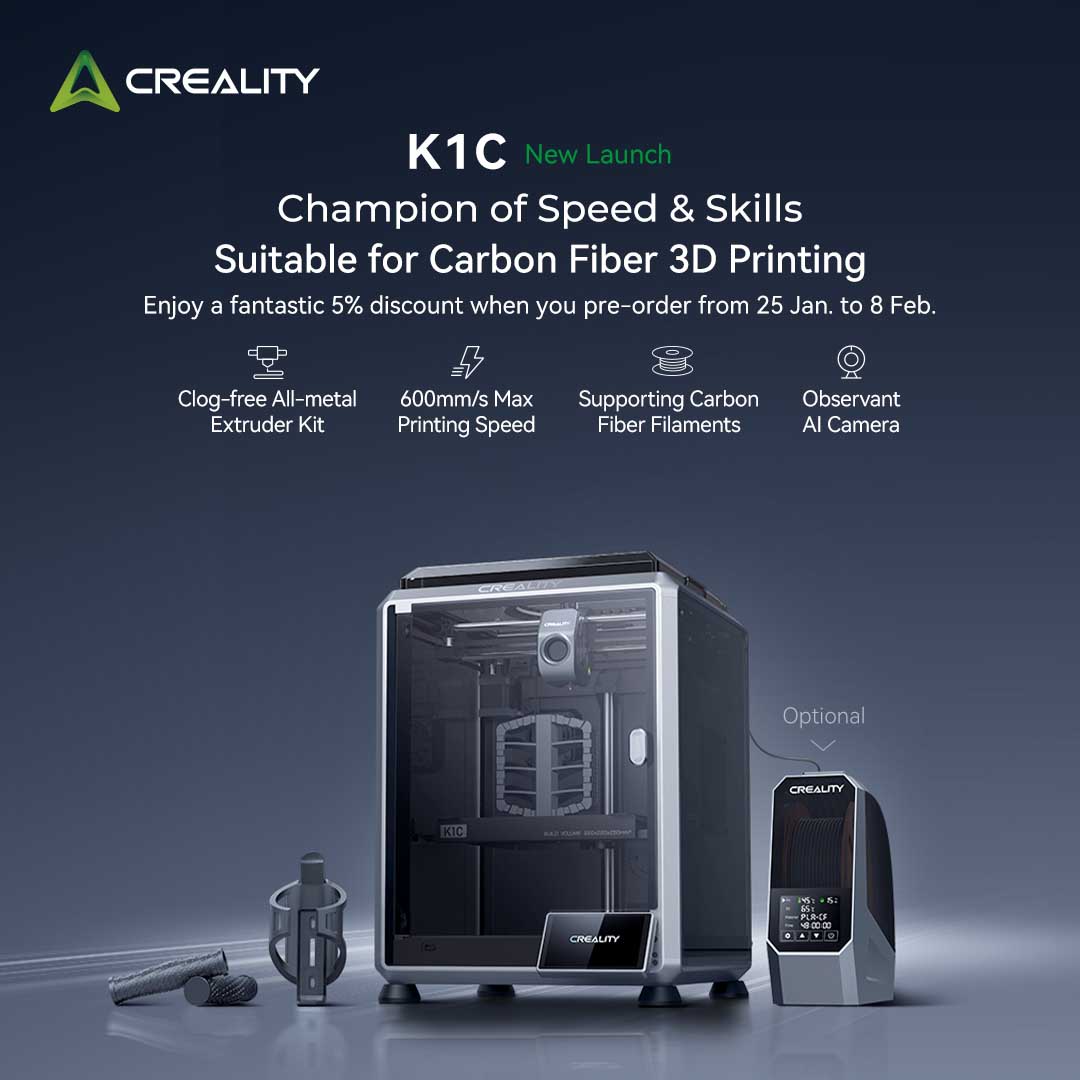
Part 1: Creality K1C 3D Printer Technical Advancements
1. Technical Overview:
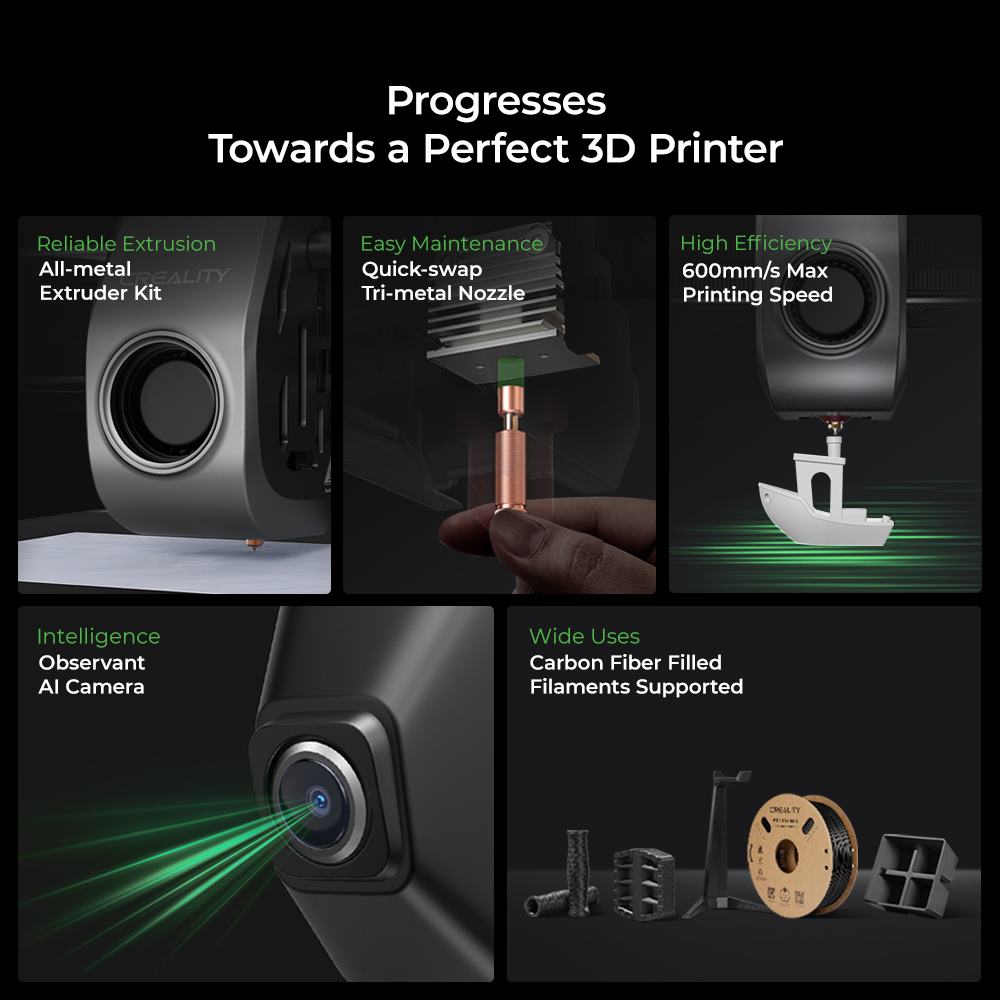
2. Innovative Highlights of the Creality K1C Printer:
2.1 Champion of Speed and Skills
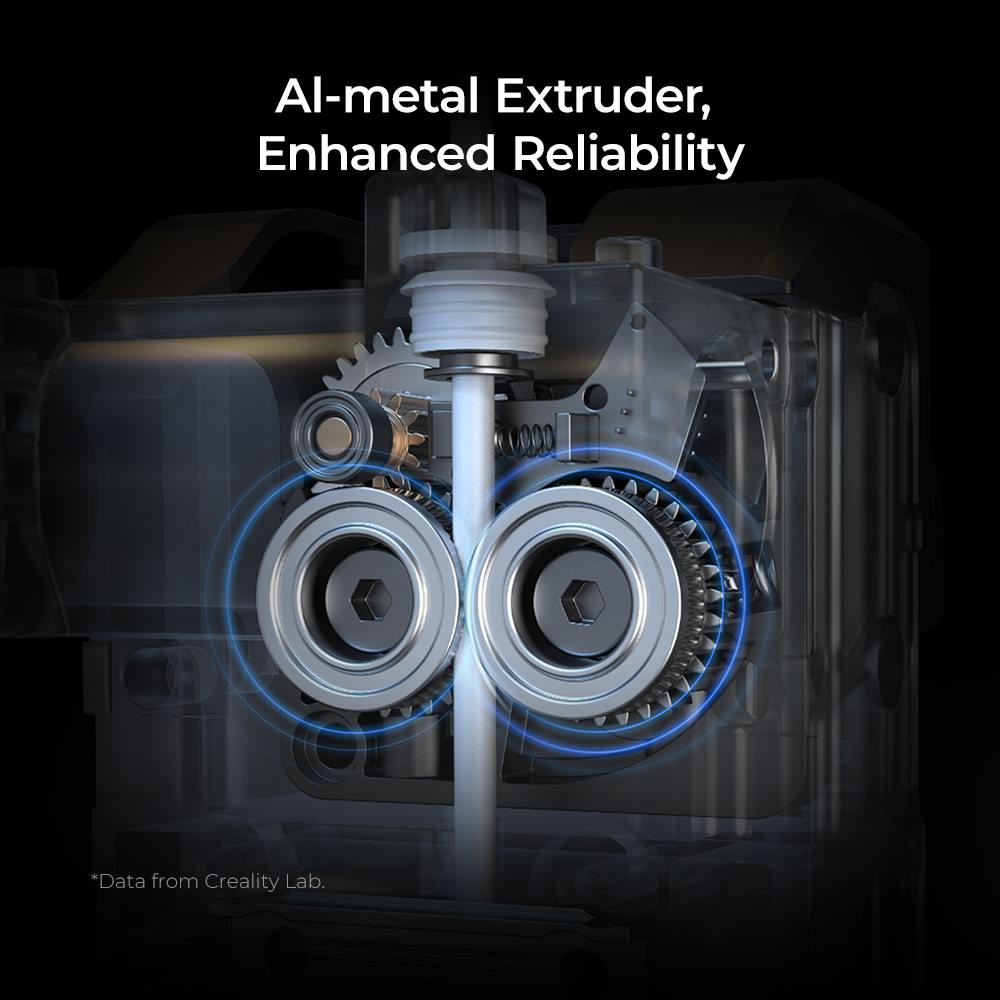
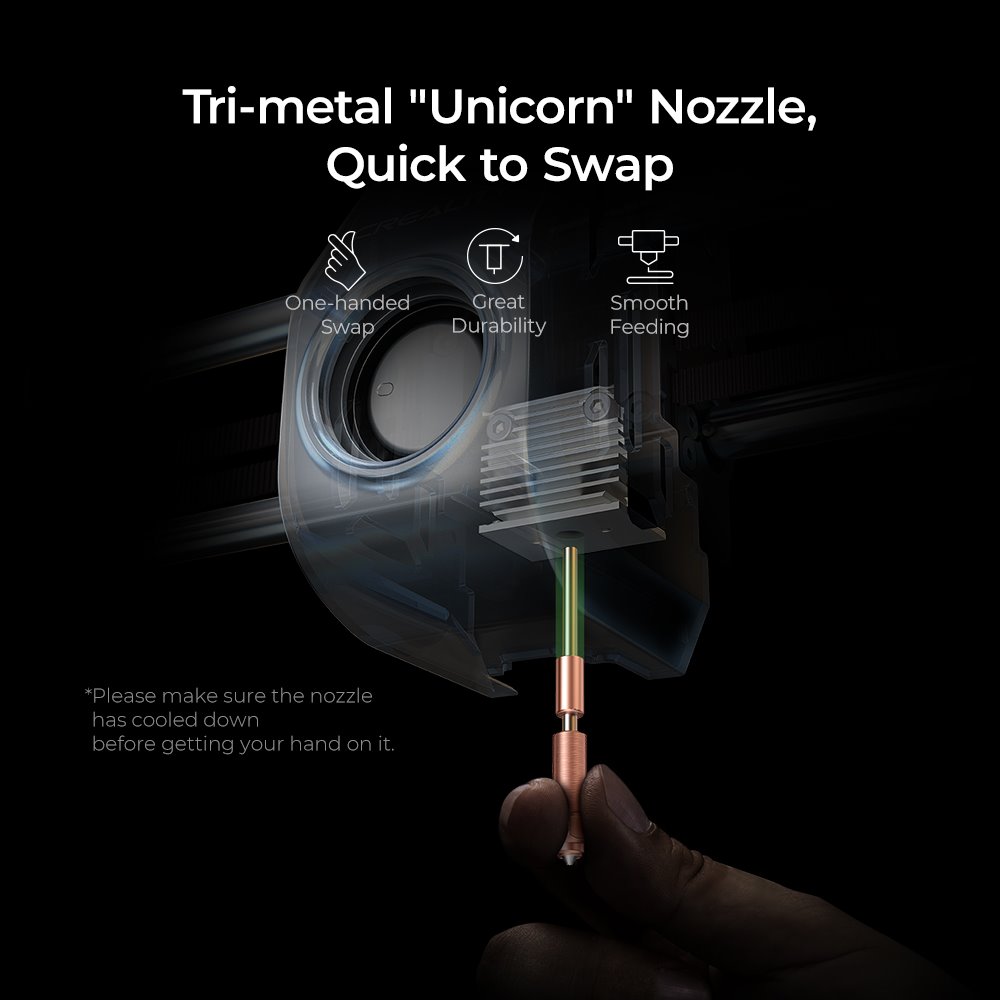
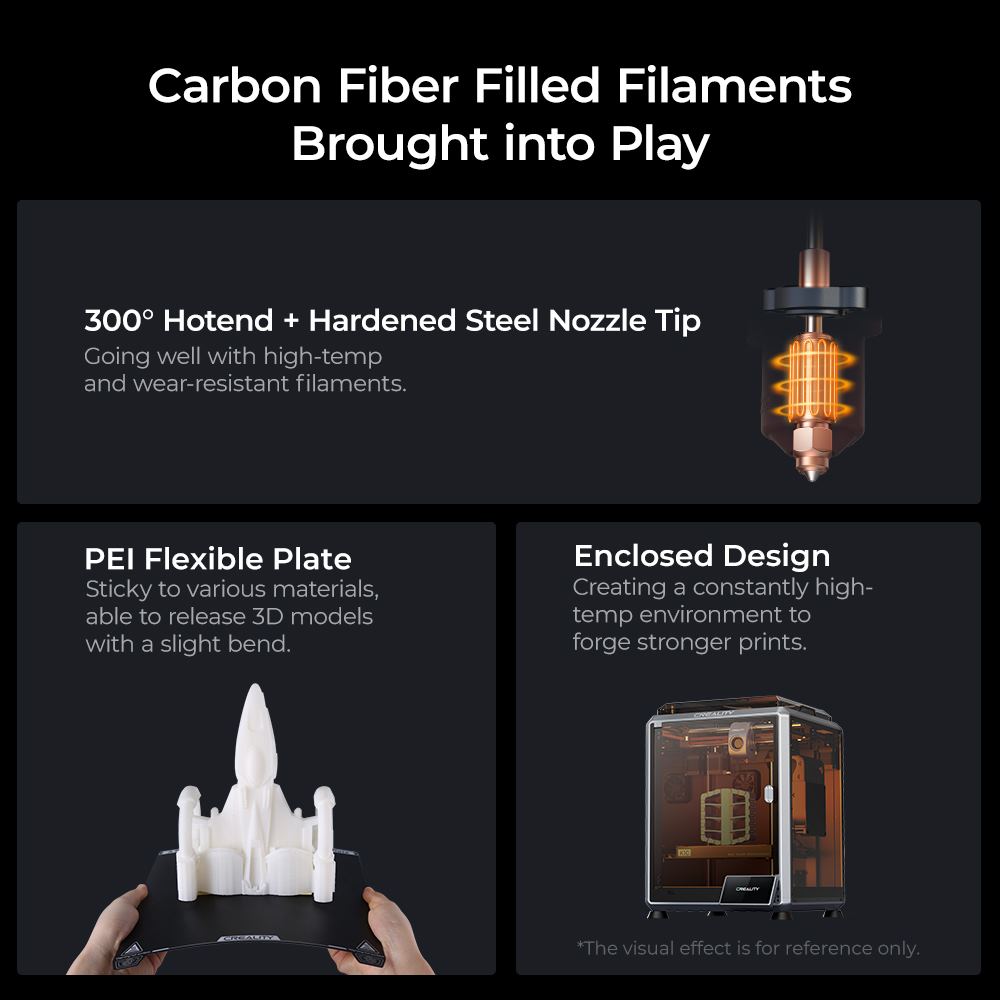
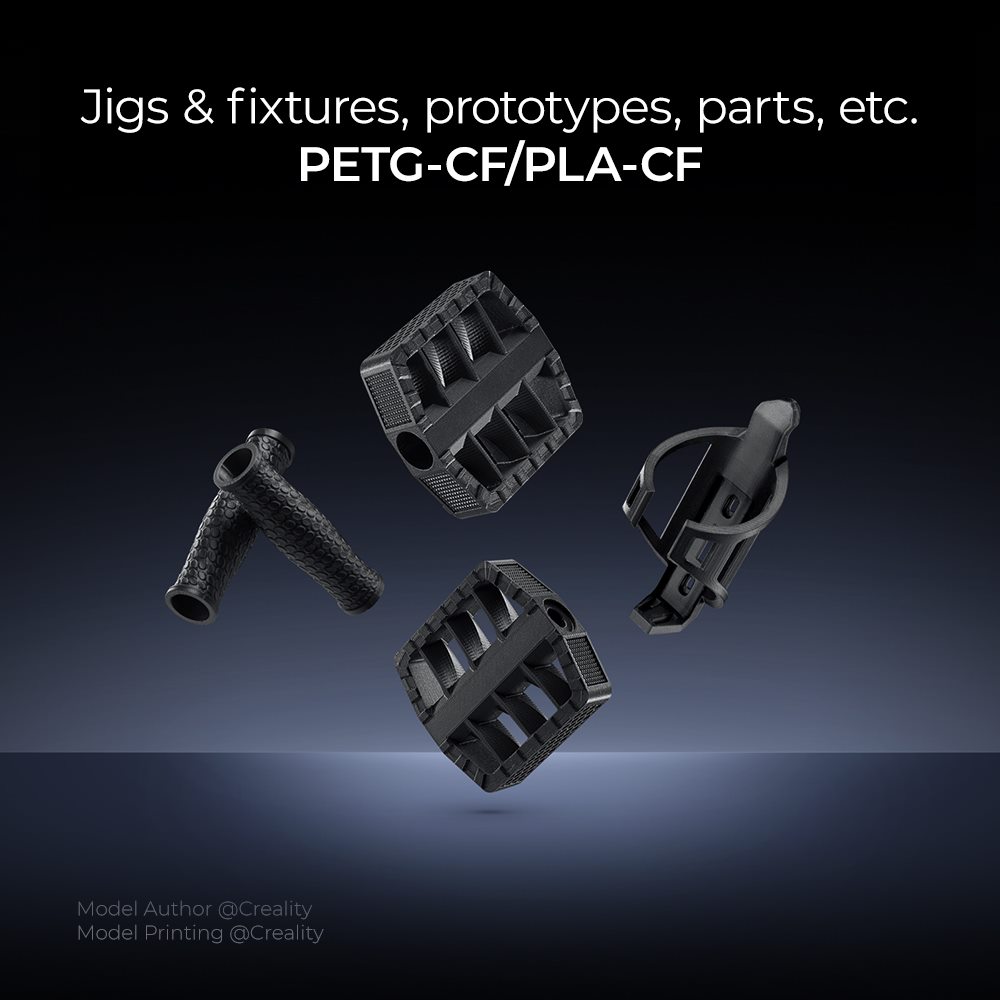
2.2 Carefree & Smart Operations
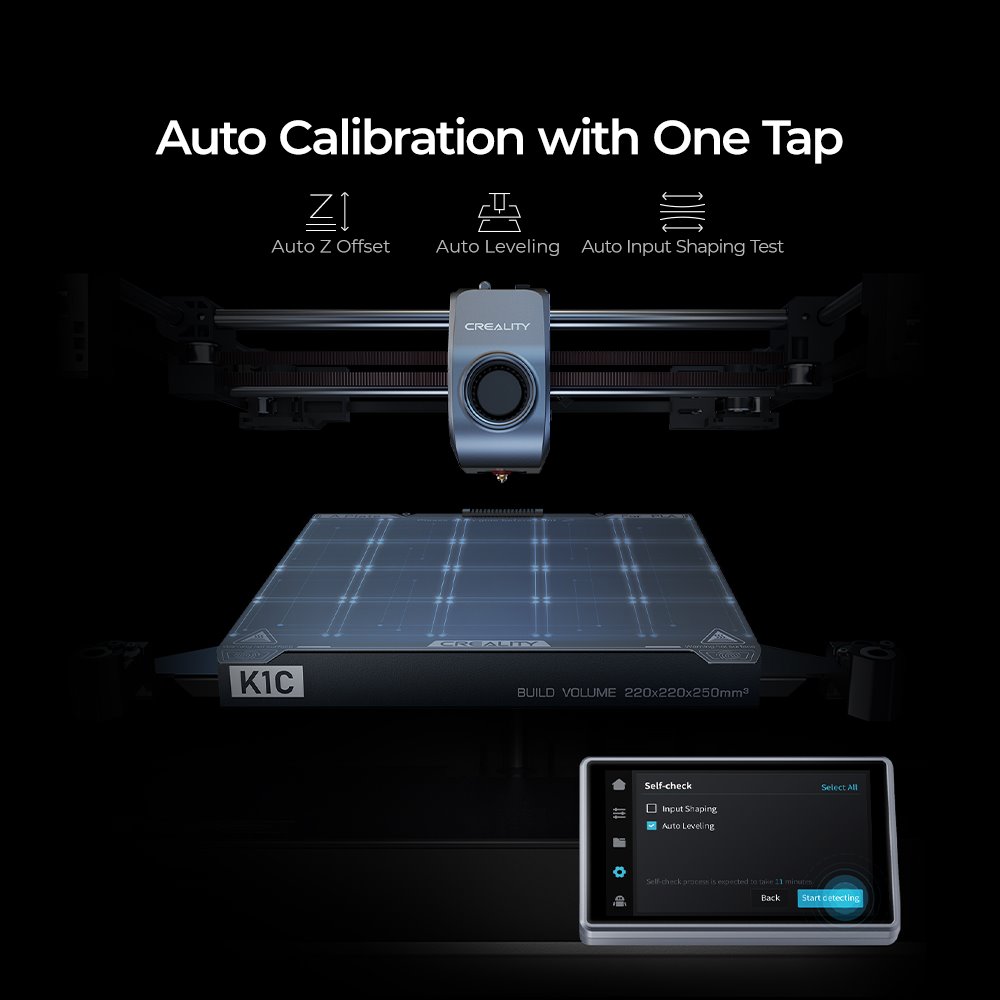
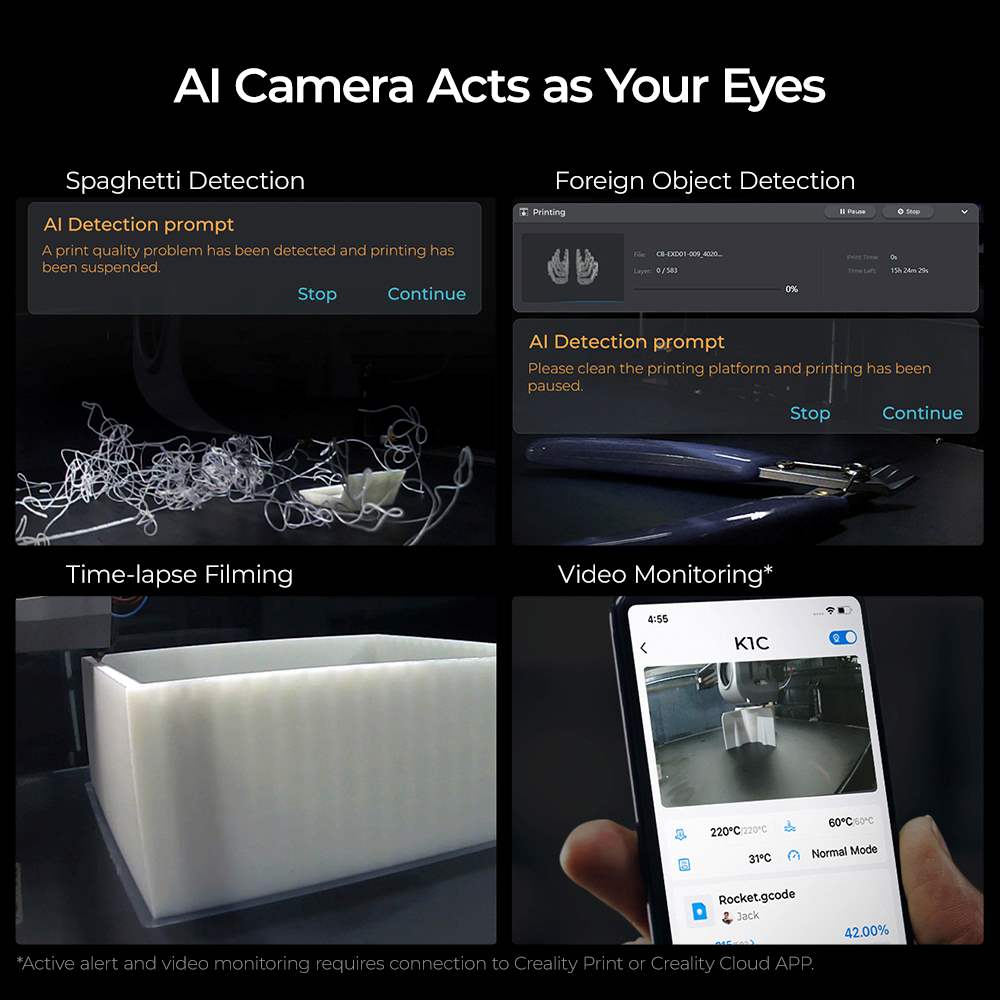
2.3 Champion of Speed, Indeed
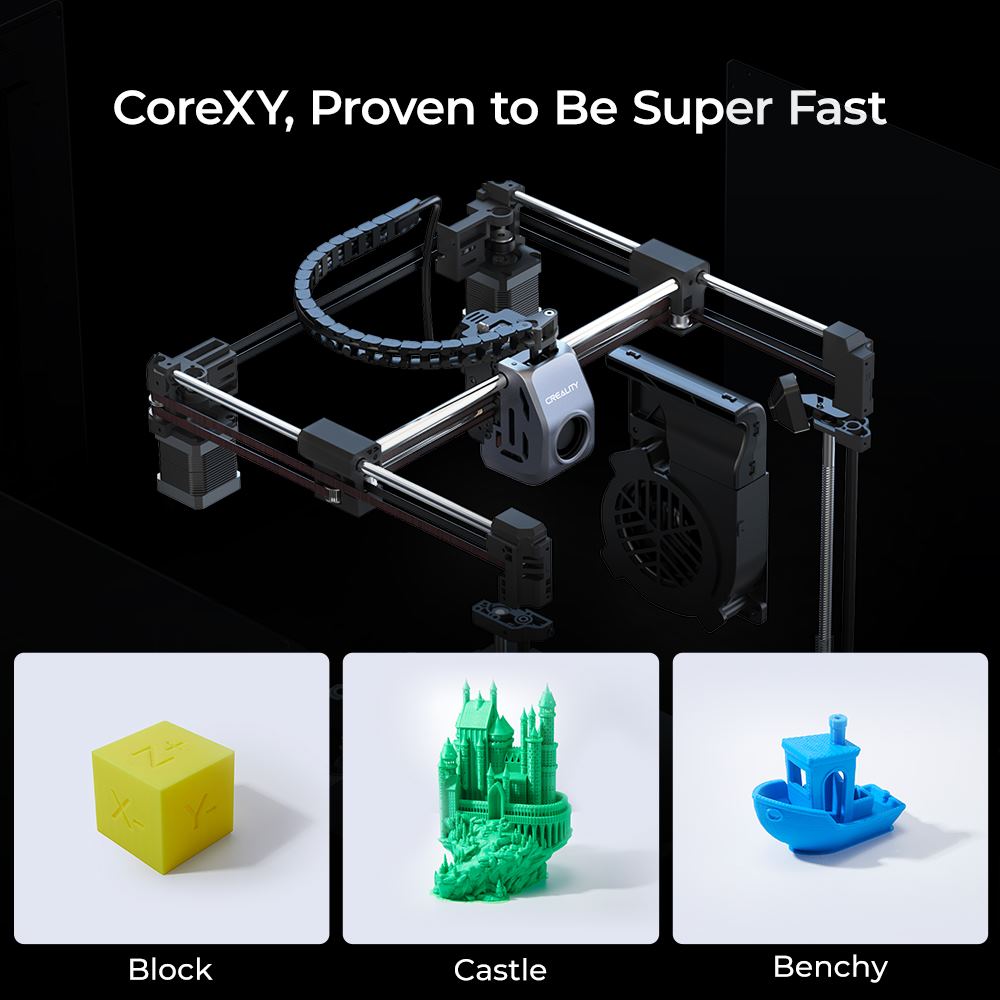
2.4 Contemporary Style and Robust Build
2.5 Advanced Creality Operating System and Exceptional Software Suite
Part 2: Creality K1 Series Parameter Comparison
Market Positioning
Creality K1 Flagship Series
Model
K1
K1 Max
K1C
KV



Release Date
2023.4
2023.4
2024.1
Printing Technology
FDM
FDM
FDM
Build Volume
(mm)220*220*250
300*300*300
220*220*250mm
Product Dimensions
(mm)355*355*480
435*462*526
355*355*482mm
Package Dimensions
(mm)415*415*550
508*508*608
428*428*567mm
Net Weight(kg)
12.5kg
18kg
12.4kg
Gross Weight (kg)
16kg
23kg
16kg
Supported Filaments
PLA, Hyper PLA, PETG, ABS,TPU,ABS,PA
Printing Accuracy
100±0.1mm
100mm±0.1
100±0.1mm
Layer Height
0.1-0.35mm
0.1-0.35mm
0.1-0.35mm
Filament Diameter
1.75mm
1.75mm
1.75mm
Build Surface
Flexible build plate
Flexible build plate
PEI flexible build plate
Heatbed Temperature
100℃
100℃
≤100℃
Nozzle Temperature
300℃
300℃
≤300℃
Extruder Count
1
1
1
Nozzle Diameter
0.4mm
0.4mm
0.4mm
Printing Speed
300mm/s
300mm/s
300mm/s
Max. Printing Speed
≤600mm/s
≤20000mm/s²≤600mm/s
≤20000mm/s²≤600mm/s
≤20000mm/s²
Display Screen
4.3" color touch screen
4.3" color touch screen
4.3" color touch screen
UI Languages
Rated Input Voltage
100-120V~/200-240V~
100-240V~
100-240V~, 50/60Hz
Output Voltage
24V
24V
24V
Rated Power
350W
1000W
350W
Silent Mainboard
Yes
Yes
Yes
Extruder
Dual-gear direct drive extruder
Dual-gear direct drive extruder
All-metal direct drive extruder
Dual Z-axis
3 Z-axis
3 Z-axis
3 Z-axis
Leveling Mode
Hands-free auto leveling
Dual hands-free auto leveling
Hands-free auto leveling
Air Purifier
x
x
√
Sleep Mode
x
x
√
Input Shaping
√
√
√
Lighting Kit
√
√
√
Power Loss Recovery
√
√
√
Filament Runout Sensor
√
√
√
Remote Printing
√
√
√
Enclosure
√
√
√
Remark
AI Camera(Optional)
AI Camera, AI LiDAR
AI Camera
File Transfer
USB drive, WiFi
USB drive, WiFi
USB drive, WiFi
Printable File Format
G-Code
G-Code
G-Code
Slicing Software
STL, OBJ, AMF
STL, OBJ, AMF
STL, OBJ, 3MF
File Formats for Slicing
Creality Print; Cura, Simplify3D, PrusaSlicer
Creality Print, Cura 5.0 and later version
Part 3: Creality K1C Applications
Applications
Filament
Features
Use
Robot Model
PLA
PLA-CF
Higher stiffness and strength
PETG
Wear-resistant with high impact strength
Can be used to print robot gears and other moving parts
ABS
Strong, Impact-resistant & Heat-resistant
ASA
Good UV resistance and weatherability
Suitable for printing robot parts used outdoors.
TPU
Flexible filament
PA
Wear-resistant & Impact-resistant
Perfect for printing robot gears and high-strength parts.
PC
High strength & Heat resistance
PA-CF
Extremely high stiffness and strength
PLA
PLA-CF
PETG
Good toughness and weather resistance
ABS
High strength and good heat resistance
ASA
High weather resistance
TPU
High elasticity
PA
PC
High transparency
PA-CF
PLA
High hardness but greater brittleness.
PLA-CF
Higher strength and stiffness
Suitable for printing the car's protective bars or bumpers.
PETG
Good toughness and heat resistance
Great for printing car engine parts or internal structures
ABS
Good heat resistance & impact resistance
Can be used to print the car's chassis or tires
ASA
Excellent weatherability and UV resistance
Suitable for printing the car's external trim pieces.
TPU
Good wear resistance and toughness
Suitable for printing the car's seats or interior trim.
PA/PA-CF
PC
High impact resistance & transparency
Suitable for printing car windows or light covers.
Furniture Design
PLA
PLA-CF
PETG
ABS
ASA
TPU
Excellent flexibility
PA
Wear-resistant and impact-resistant
PC
Strong and transparent plastic
PA-CF
PLA
PLA-CF
High rigidity, strength, and lower weight
PETG
ABS
High strength and heat resistance
ASA
Weather resistance & high wear resistance
Can be used to print car roofs, window frames, etc.
TPU
Good elasticity and wear resistance
PA/PA-CF
PC
Can be used to print car windows, light covers, etc.
FAQs about Creality K1C 3D Printer
1. Has the Creality K1C been released for purchase?
2. What is the price of the Creality K1C?
3. Are there any special deals for the Creality K1C during the pre-sale?
4. Why is it called K1C, and what makes it a high-speed 3D printer for carbon fiber materials?
5. What are the key speed and quality features of the Creality K1C 3D Printer?
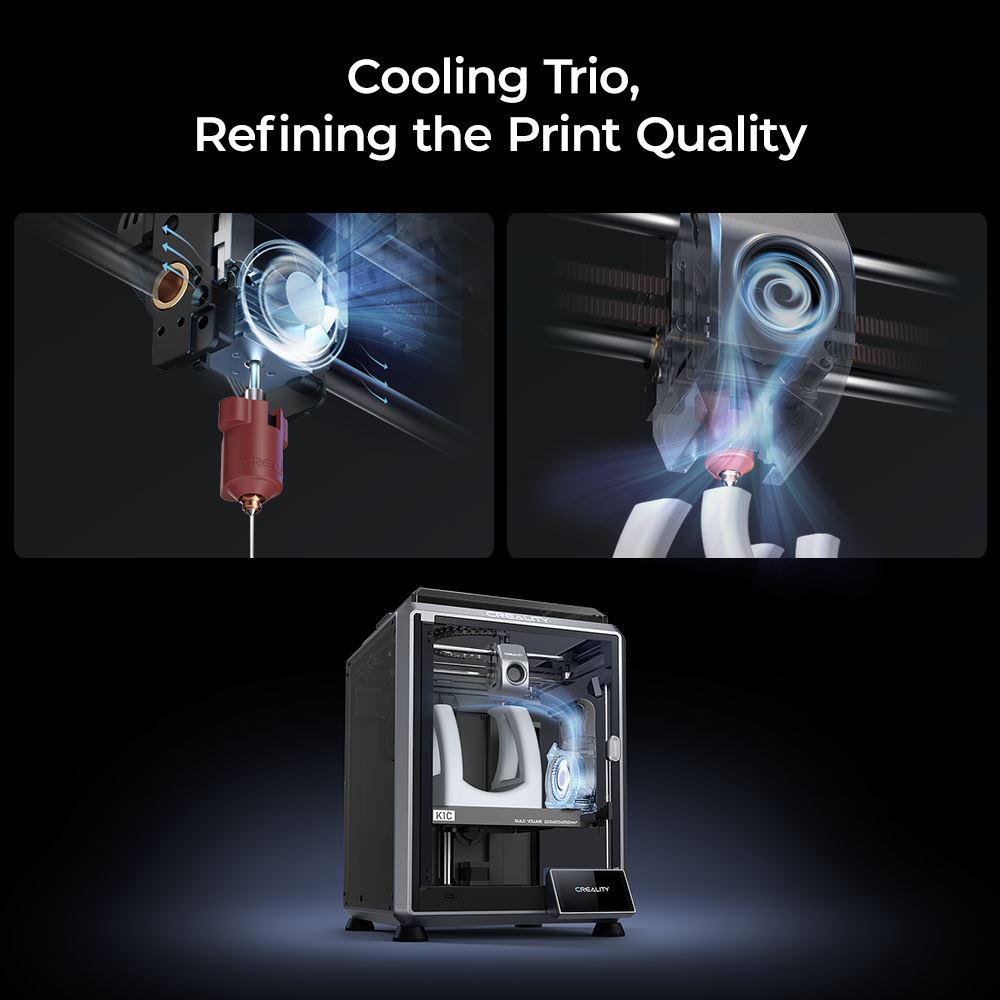
6. What additional support and convenience features does the Creality K1C 3D Printer offer?
7. What optimizations are in the Creality K1C 3D Printer, enhancing material diversity?
8. How does the Creality K1C balance speed and quality in its printing process?
9. What user-friendly features make the Creality K1C an easy-to-use 3D printer?
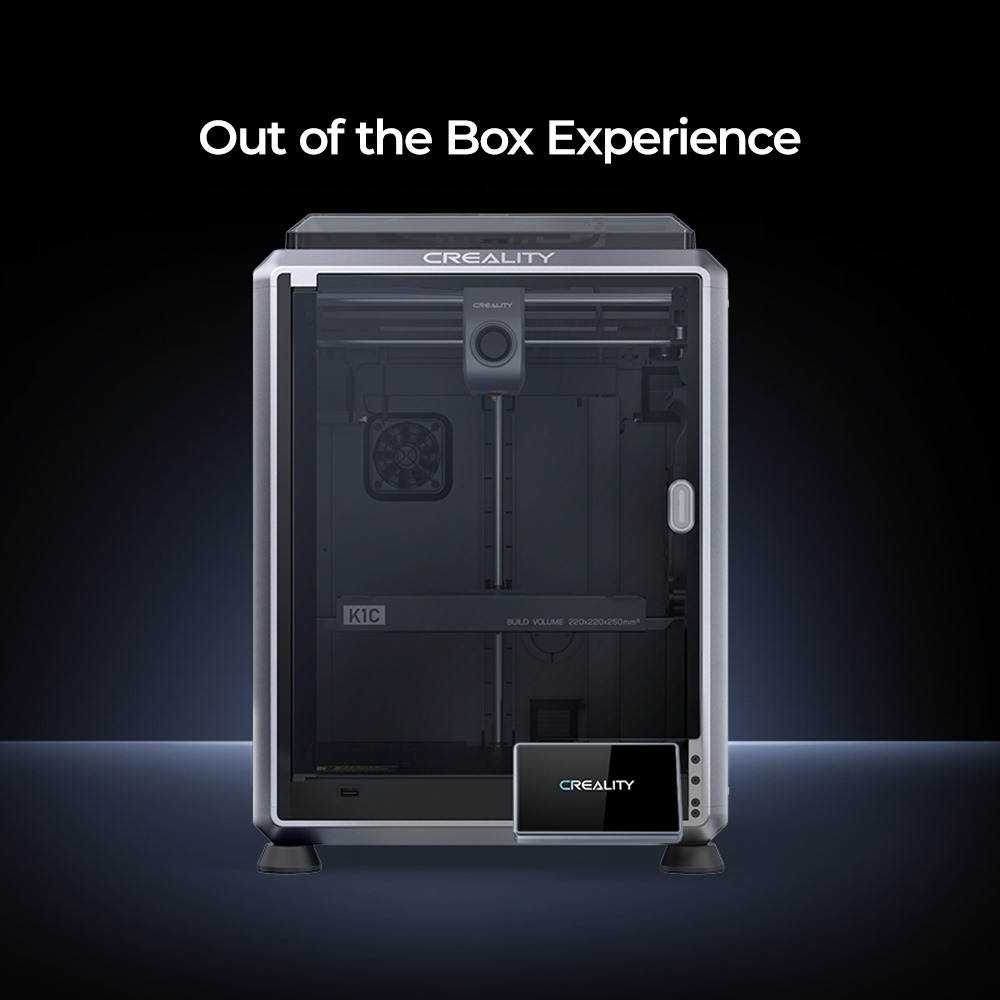
Conclusion: The Creality K1C transcends the typical capabilities of a 3D printer, providing an all-inclusive package tailored for complex printing needs. It comes equipped with a fusion of rapid printing abilities, robust construction, and cutting-edge functionalities. Supported by a one-year warranty, round-the-clock customer support, and an extensive selection of both hardware and software resources, the K1C is set to revolutionize the 3D printing industry. It's an ideal choice for creating everything from tools and fixtures to prototypes, casings for products, and even toys, ensuring superior print quality with impressive velocity.
Unveiling the Latest Creality K1C 3D Printer: Dive into the Details
2024-03-01
2 COMMENTS
e - Mon Nov 03 17:50:41 UTC 2025
e
0
e - Sun Jun 29 02:15:38 UTC 2025
e
0
Tags
Share
Most People Read
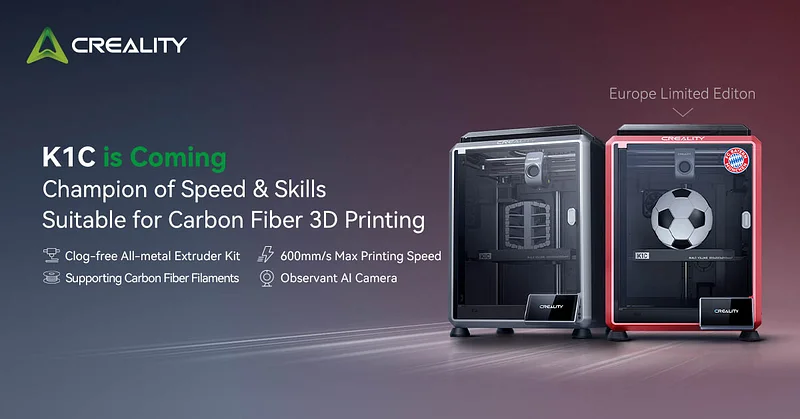
Unveiling the Latest Creality K1C 3D Printer: Dive into the Details
K1 Series 3D Printers
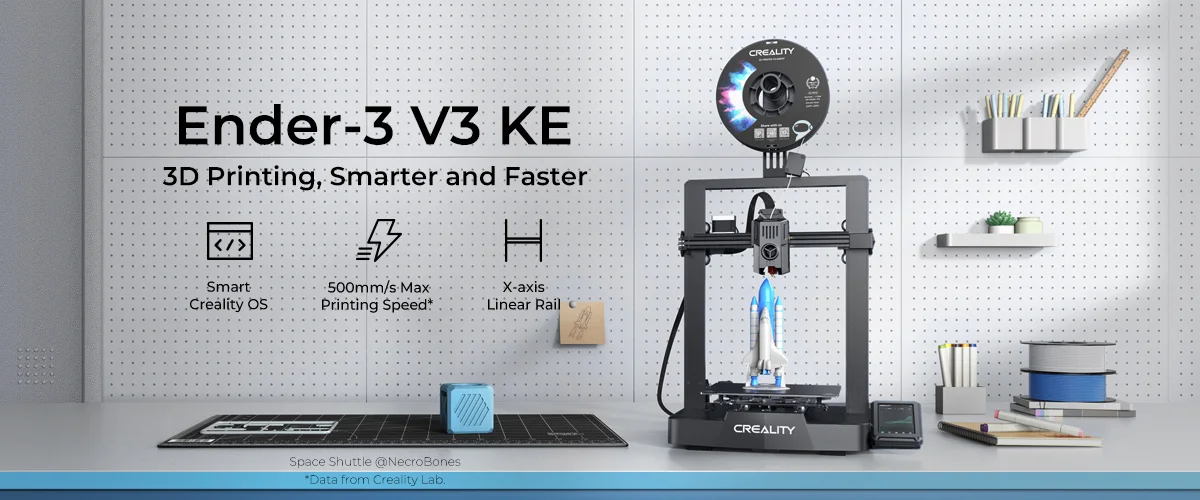
Creality Ender 3 V3 KE Compared to Ender 3 V3 SE
This article is all about introducing the innovative Ender 3 V3 KE, highlighting its upgraded features, and showing you how it's poised to revolutionize your 3D printing experience.
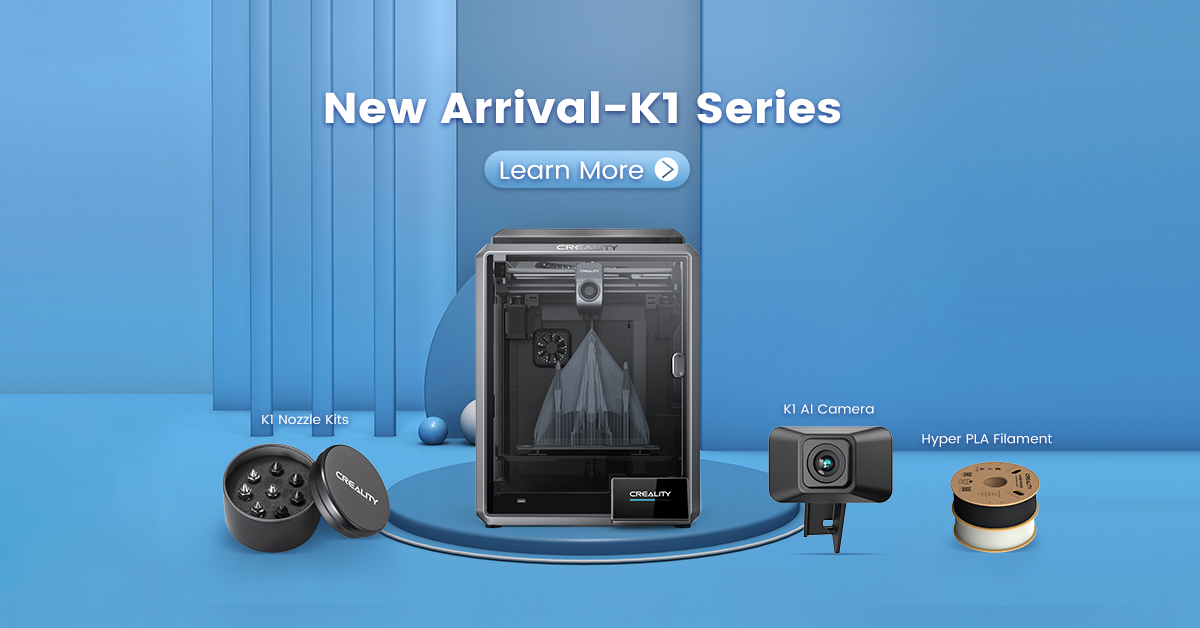
Do You Know About the Creality K1 Speedy 3D Printer?
Creality k1 is Creality's flagship series of printers officially launched in June 2023. Once released, it has been chosen by the majority of 3D printer enthusiasts, bringing us a brand new printing experience.

